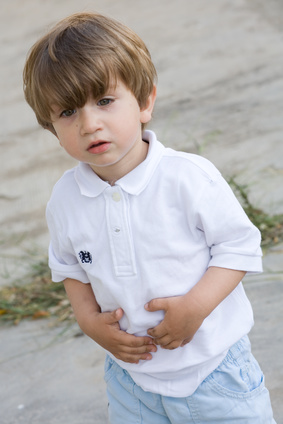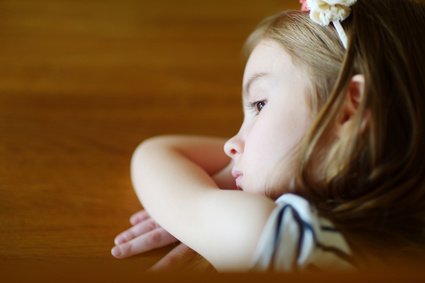When the Worry Bugs Are in Your Tummy: Helping a Child with Anxiety
When my daughter was anxious she used to tell me, “Mama, my tummy feels like it is making butter.” After ruling out sickness, I told her tummies sometimes get upset when there are worries in them. She replied with, “I don’t know what I am worried about.” I took her words at face value because the reality is we don’t always know what stirs us up. The brain has its own reasons for activating emotional arousal and we are not always conscious of why this is so. Alarm and fear are like this – they have a way of getting so big we are blinded as to their true source.
One of my niece’s told me at the dinner table the other night that she felt sick to her stomach as she ate. After asking her some questions I told her I thought they might be ‘worry bugs.’ I asked her to sit on my lap and I put a hand on her tummy and said it felt like worry bugs to me. I asked her if she knew what she was worried about? She said, “I am not worried at all!” I replied that when the worry bugs are in your tummy and not in your head, we usually don’t know what they are about and this is okay. I said thought the worry bugs would move and eventually come out of her mouth if we just gave it time.
 A half hour later my niece said the worry bugs had moved and were no longer in her tummy. I asked where they were located and she said, “in my throat.” I asked her to open her mouth and then looked inside it and said, “oh yes, they look like worry bugs alright.” I let her know that I thought they would come out soon too. Later on that evening she came to find me and said that she thought I was right, that she really did have worry bugs in her tummy. She said she realized she was worried about watching the movie the kids had picked out because it looked scary to her. She said that after she watched a little of it she thought she could handle it. I asked her if there were any worry bugs left and she said, “No, they are all gone now.”
A half hour later my niece said the worry bugs had moved and were no longer in her tummy. I asked where they were located and she said, “in my throat.” I asked her to open her mouth and then looked inside it and said, “oh yes, they look like worry bugs alright.” I let her know that I thought they would come out soon too. Later on that evening she came to find me and said that she thought I was right, that she really did have worry bugs in her tummy. She said she realized she was worried about watching the movie the kids had picked out because it looked scary to her. She said that after she watched a little of it she thought she could handle it. I asked her if there were any worry bugs left and she said, “No, they are all gone now.”
My niece was afraid yet rendered speechless about it. She is also very sensitive and things can stir her up easily. She didn’t have words for what made her afraid, only nameless worries in her tummy. The answer is not to tell a child to calm down, to tell them to make the worries go away, or to have them think positively. The goal is to invite the child to express what is stirring them up through words. It is our invitation to them to express their worries that helps bring the emotional system back into balance. It is the increased awareness of what stirs them up along with being able to make sense of it that helps bring emotions to rest.
Inviting Emotional Expression
If we want our children to have a relationship with their emotions and find feelings names to attach to them, then we will need to start by inviting them to express themself. The biggest obstacle to expression is believing there will be some repercussion to one’s relationship for speaking one’s heart and mind. If sharing a piece of yourself leads to further distance from someone you wish to be close to, then the brain is faced with a dilemma. The hunger for attachment wins over the need to express oneself and the self is supressed for the sake of preserving a relationship. In other words, children won’t share their feelings with us if it interferes with getting their relational needs met. This is not intentional nor done consciously but is instinctive in origin.
There are a number of strategies that are helpful in encouraging a child to express their heart’s contents but they all rely on being in right relationship with a child. This means the parent is considered to be a warm, caring, and generous caretaker that the child can rely on. A child must be deeply attached so as to want to share their secrets in a vulnerable way.
- Invite expression by conveying warmth and a willingness to listen – If we want a child to communicate their internal world to us we will need to listen with our own emotional system. This is where our intuition and capacity to read a child’s emotions and needs is critical. We will need to convey a desire to hear what they have to say and listen with full attention.
- Make room for expression – There needs to be enough time and space for a child to be able to consider their internal world. This might be done when they are free to play and are not preoccupied with peers, screen time, schooling or instruction. To bring emotions into consciousness requires not only an invitation but room. Jaak Pankseep, a leading neuroscientist, states children need ‘play sanctuaries’ for the purpose of emotional expression.
- Come alongside their feelings – When a child is expressing their feelings or thoughts the goal is to listen and come alongside them. This will increase the likelihood that they will tell us more and be able to feel in a more vulnerable way. Coming alongside means we acknowledge what a child has said, for example, “yes, worry bugs come when we are thinking about scary movies sometimes.” To come alongside means we don’t discount, negate, judge, problem solve, or try to teach them a lesson when they are sharing their experiences. The goal is to communicate that we are hearing them which helps to bring the emotions into full consciousness.
- Hide your own emotional needs – When we are trying to help a child with their own emotions then it is important not to trump this with our own emotional expression. Parents need to hide how they are stirred up in order to make the focus on the child’s internal world. If a child sees or believes that what they share will be too hard for a parent, they may preserve their relationship and supress their feelings. Our job is to hold onto their feelings and guide them in finding their way through them. Our own emotions will only serve to cloud the picture and likely alarm or confuse them.
- Help a child name their emotions with feeling words – Emotions are the raw impulses that arouse us based on stimuli from the environment. Our feelings are the names that we give these emotional states, such as fear, upset, sadness, or frustration. Humans are unique in their capacity to be able to reflect and become aware of their instincts and emotions. This development takes time and needs support from adults who can guide kids to give names to their emotions.
 When it comes to emotional expression we think the answer is to calm our kids down when what helps them find a way through is to become conscious of what stirs them up. We cannot control our emotional arousal – it happens to us. What we can do is to help our kids get their hands on the steering wheel and form intentions about what to do with their feelings.
When it comes to emotional expression we think the answer is to calm our kids down when what helps them find a way through is to become conscious of what stirs them up. We cannot control our emotional arousal – it happens to us. What we can do is to help our kids get their hands on the steering wheel and form intentions about what to do with their feelings.
Anxiety is part of the human condition, we need not pathologize it. We were meant to be stirred up – sometimes with ‘worry bugs’ or with ‘tummies that make butter.’ The emotions that challenge us the most are the ones that have no names and no room for expression.
Our emotions are not problems, they are just trying to fix the problems in our life. We need to teach our kids to listen to their internal emotional world by guiding them and having faith that balance and stability was never achieved by cutting out feelings but by letting them loose.
When we are confident that there is a way through, our children will follow us. Resilient kids are those that feel a lot, have names for their feelings, and believe that facing what upsets them is the surest way through the storms in life.
Dr. Deborah MacNamara is the author of Rest, Play, Grow: Making Sense of Preschoolers (or anyone who acts like one), is on faculty at the Neufeld Institute, and Director of Kid’s Best Bet, a counselling and family resource center. For more information please see www.macnamara.ca and www.neufeldinstitute.org.





